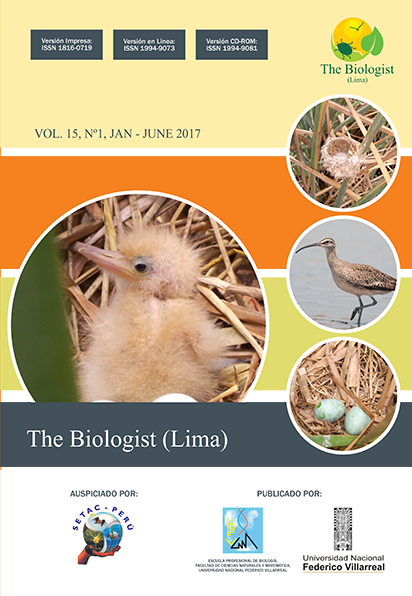¿SON LOS COPEICILLOS NEOTROPICALES (CYANERPES SPP.) UN CASO CURIOSO DE MORFOLOGÍA CONVERGENTE CON LOS PÁJAROS SOL AFRICANOS (NECTARINIIDAE) O UN ESLABÓN RELICTO GONDWANIANO ENTRE ÉSTOS Y LOS COLIBRÍES (TROCHILIDAE)?
DOI:
https://doi.org/10.24039/rtb2017151138Keywords:
colibríes, Cyanerpes spp., ecofilogenética, ecomorfología, evolución convergente, pájaros solAbstract
La coincidencia entre los pájaros sol (Nectariniidae) africanos con los copeicillos (Thraupidae) y colibríes (Trochilidae) del Neotrópico, particularmente usando el vuelo cernido para libar el néctar y atrapar insectos, crea dudas razonables de si se trata de un simple caso de equivalentes ecológicos por evolución convergente (i.e., Trochilidae vs. Nectariniidae) o un parentesco en propiedad entre un grupo nectarívoro relicto (Cyanerpes spp.) y los nectarínidos. Sobre la base de dos hallazgos inusitados, se replantean los conflictivos problemas en la sistemática entre especies de aves, magnificados por la carencia de resolución en los análisis moleculares, el imperfecto muestreo taxonómico, los desaciertos acerca de la extensión de la morfohomoplasia y la escasez de fósiles con caracteres plesiomórficos bien preservados. El primer hallazgo tiene que ver con una nueva especie de cestodo, Staphylepis ambilateris Mariaux & Vaucher 1991, descubierta en especies de aves nectarínidas africanas, y su sorprendente similitud morfoanatómica con la especie S. inhamata Rietschel 1934, obtenida de colibríes sudamericanos. El segundo, con el descubrimiento de fósiles de colibríes en el continente europeo, que permiten inferir que los Trochilidae tuvieron su origen en el Viejo Mundo en los inicios del período Terciario. El resurgimiento de la ecomorfología y la ecofilogenética pudiera terminar de esclarecer, parcialmente, los genuinos parentescos entre linajes aviares con historias filogeográficas enigmáticas.Downloads
References
Altshuler, D.L. & Dudley, R. 2002. The ecological and evolutionary interface of hummingbird flight physiology. The Journal of Experimental Biology, 205: 2325–2336.
Arendt, J. & Reznick, D. 2008. Convergence and parallelism reconsidered: what have we learned about the genetics of adaptation? Trends in Ecology and Evolution, 23: 26–32.
Baker, R.H.; Yu, S. & Desalle, R. 1998. Assessing the relative contribution of molecular and morphological characters in simultaneous analysis trees. Molecular Phylogenetics and Evolution, 9: 427–436.
Beecher, W. 1951. Convergence in Coerebidae. Wilson Bulletin, 63: 274–297.
Bleiweiss, R. 1998. Origin of hummingbird faunas. Biological Journal of the Linnean Society, 65:77–97.
Bochenski, Z. & Bochenski, Z.M. 2008. An old world hummingbird from the Oligocene: a new fossil from Polish Carpathians. Journal of Ornithology, 149:211–216.
Briggs, J.C. 2003. Fishes and birds: Gondwana life rafts reconsidered. Systematic Biology, 52:548–553.
Brown, M.; Downs, C. T. & Johnson, S. D. 2010. Concentration-dependent sugar preferences of the Malachite Sunbird (Nectarinia famosa). The Auk, 127:151–155.
Burns, K.J.; Hackett, S.J. & Klein, N.K. 2003. Phylogenetic relationships of Neotropical honeycreepers and the evolution of feeding morphology. Journal of Avian Biology, 34: 360–370.
Cheke, R.A. & Mann, C.F. 2008. Family Dicaeidae (Flowerpeckers). In: Handbook of the birds of the world. Vol. 13. del Hoyo, J.; Elliott, A. & Christie, D.A. (eds.). Lynx Edicions. Barcelona, Spain. pp. 350–388.
Cheke, R.A. & Mann, C.F. 2008. Family Nectariniidae Sunbirds). In: Penduline-tits to Shrikes. Handbook of the birds of the world, Vol. 13. del Hoyo, J.; Elliott, A. & Christie, D.A. (eds.). Lynx Edicions. Barcelona, Spain. pp. 196–321.
Collins, B. & Patton, C. 1989. Consequences of differences in body mass, wing length and leg morphology for nectar-feeding birds. Austral Journal of Ecology, 14: 269–289.
Collar, N.J. & Robson, C. 2007. Family Timaliidae (Babblers). Picathartes to Tits and Chickadees.In: Handbook of the birds of the world, Vol. 12. Del Hoyo, J.; Elliott, A. & Christie, D.A. (eds.). Lynx Edicions. Barcelona, Spain. pp. 70–291.
Cooper, A.; Lalueza-Fox, C.; Anderson, S.; Rambaut, A.; Austin, J. & Ward, R. 2001. Complete mitochondrial genome sequences of two extinct moas clarify ratite evolution. Nature, 409: 704–707.
Croizat, L. 1982. Vicariance, vicariism, panbiogeography, vicariance biogeography, etc. A clarification. Systematic Zoology, 31: 291–304.
Ericson, G.P. 2008. Current perspectives on the evolution of birds. Contributions to Zoology, 77: 109–116.
Fain, M.G. & Houde, P. 2004. Parallel radiations in the primary clades of birds. Evolution, 58: 2558–2573.
Farquhar, M.R.; Lorenz, M.; Rayner, J.L. & Craig, A.J.F.K., 1996. Feather ultrastructure and skeletal morphology as taxonomic characters in African sunbirds (Nectariniidae) and sugarbirds (Promeropidae). Journal of African Zoology, 110: 321–331.
Feduccia, A. 1995. Explosive evolution in Tertiary birds and mammals. Science, 201: 644–654.
Fleming, P. A.; Bakken B.; Lotz, N. & Nicolson W. 2004. Concentration and temperature effects on sugar intake and preferences in a sunbird and a hummingbird. Functional Ecology, 18: 223–232.
Fry, C.H. 2000. Family Nectariniidae: sunbirds and spiderhunters. In: The birds of Africa. Vol. 6: Picathartes to Oxpeckers. Fry, C. H.; Keith S. & Urban E.K. (eds.). Academic Press. London. pp. 135–305.
Geerts, S. & Pauw, A. 2009. African sunbirds hover to pollinate an invasive hummingbirdpollinated plant. Oikos, 118: 573–579.
Hackett, S.; Kimball, R.T.; Reddy, S. Bowie, R.C.K.; Braun, E.L.; Braun, M.J.; Chojnowski, J.L.; Cox, W.A.; Han, K.-L.; Harshman, J.; Huddleston, C.J.; Marks, B.D.; Miglia, K.J.; Moore, W.S.; Sheldon, F.H.; Steadman, D.W.; Witt, C.C. & Yuri, T. 2008. A phylogenomic study of birds reveals their evolutionary history. Science, 320: 1763–1768.
Hickerson, M.J.; Meyer, C.P. & Moritz C. 2006. DNA barcoding will often fail to discover new animal species over broad parameter space. Systematic Biology, 55: 729–739.
Higgins, P. J.; Christidis, L. & Ford, H.A. 2008. Family Meliphagidae (honeyeaters). In: Handbook of the birds of the world. Vol. 13: Penduline-tits to Shrikes. Del Hoyo, J.; Elliott, A. & Christie, D. (eds.). Lynx Edicions. Barcelona. pp. 498–691.
Hillis, D.M. 1987. Molecular and morphological approaches to systematics. Annals and Reviews in Ecology and Systematics, 18: 23–42.
Houde, P. 1987. Critical evaluation of DNA hybridization studies in avian systematics. Auk, 104: 17–32.
Irwin, M.P.S. 1999. The genus Nectarinia and the evolution and diversification of sunbirds: an Afrotropical perspective. Honeyguide, 45: 45–58.
Janeček, S.; Patáčová, E.; Bartoš, M.; Padyšáková, E.; Spitzer, L. & Tropek, R. 2010. Hovering sunbirds in the Old World: occasional behaviour or evolutionary trend? Oikos, 120:178–183.
Janeček, S.; Bartoš, M. & Njabo, K. 2015. Convergent evolution of sunbird pollination systems of Impatiens species in tropical Africa and hummingbird systems of the New World. Biological Journal of the Linnean Society, 103: 696–706.
Johnson, S.D. & Nicolson, S.W. 2008. Evolutionary associations between nectar properties and specificity in bird pollination systems. Biological Letters, 4:49–52.
Lanyon, S.M. 1992. Review of Sibley and Ahlquist 1990. Condor, 94:304–307.
Lawver, L.A. & Gahagan, L.M. 2003. Evolution of Cenozoic seaways in the circumAntarctic region. Palaeogeography , Palaeoclimatology and Palaeoecology, 198:11–37.
Leon, B. & Nicolson, S.W. 1997. Metabolic rate and body temperature of an African Sunbird, Nectarinia chalybea: daily rhythm and the effect of ambient temperature. South African Journal of Zoology, 32:31–36.
Leseigneur, C.D. & Nicolson, S.W. 2009. Nectar concentration preferences and sugar intake in the White-bellied Sunbird, Cinnyris talatala (Nectariniidae). Journal of Comparative Physiology, 179:673–679.
Louchart, A.; Tourment, N.; Carrier, J.; Roux, T. & Mourer-Chauviré, C. 2008. Hummingbird with modern feathering: an exceptionally well-preserved Oligocene fossil from southern France. Naturwissenschaften, 95: 171–175.
Mariaux, J. & Vaucher, C. 1991. A new species of Staphylepis Spassky&Oshmarin 1954 (Cestoda: Hymenolepididae) found in West African nectariniid birds. Revue Suisse de Zoologie, 98:261–268.
Marín, G. 2010. Acerca del origen y biogeografía del Pantepuy o Croizat versus Mayr: Una revisión crítica. The Biologist (Lima), 6:79–108.
Marín, G.; Guevara, S.; Prieto, A.; Muñoz, J. & Carvajal, Y. 2011. Comercialización ilegal de aves silvestres: un caso en Venezuela. The Biologist (Lima), 9:38–52.
Marín, G. & Durán, M. 2016. Ornitofrugivoría en Stenocereus griseus (Haw.) Buxb y Cereus repandus Mill. (Cactaceae) durante el período de lluvias en un hábitat xerofítico litoral del nororiente de Venezuela. The Biologist (Lima), 14:397–411.
Mata, A. 2010. Metabolic rate and specific dynamic action of the Red-legged Honeycreeper, a nectar-feeding Neotropical passerine. Comparative Biochemistry and Physiology, Part A, 157:291–296.
Mayr, G. 2004. Old world fossil record of moderntype hummingbirds. Science, 304:861–864.
Mayr, G. 2005. Fossil hummingbirds in the Old World. Biologist, 52:12–16.
Mayr, G. 2008. The higher-level phylogeny of birds - when morphology, molecules, and fossils coincide. Oryctos, 7:67–73.
McCraken, K.G. & Sheldon, F.H. 1998. Molecular and osteological heron phylogenies: Sources of incongruence. The Auk, 115:127–141.
McWhorter, T.J., Martínez del Río, C. & Pinshow, B. 2003. Modulation of ingested water absorption by Palestine sunbirds: evidence for adaptive regulation. Journal of Experimental Biology, 206:659–666.
Meyer, C.P. & Paulay, G. 2005. DNA bar coding: error rates based on comprehensive sampling. Public Library of Science Biology, 3:2229–2238.
Miller, R.S. 1985. Why hummingbirds hover? Auk, 102:722–726.
Moreno-Klemming, J. 2002. La evolución de las estrategias vitales. En: Evolución: La base de la biología. Soler, M. (eds.). Proyecto Sur. España. pp.158–176.
Nelson, G.J.; Williams, E.M. & Evans, M.C. 2001. A question of conflict. Three-items and standard parsimony compared. Systematics and Diversity, 1:145–149.
Nicolson, S.W. & Fleming, P.A. 2014. Drinking problems on a 'simple' diet: physiological convergence in nectar-feeding birds. Journal of Experimental Biology, 217:1015–1023.
Packer, L.; Gibbs J.; Sheffield, C. & Hanner, R. 2009. Barcoding methodology and applications: DNA barcoding and the mediocrity of morphology. Molecular Ecology Resources, 9: 42–50.
Padyšáková, E. & Janeček, S. 2016. Sunbird hovering behavior is determined by both the forager and resource plant. Biotropica in press.
Philippe, H.; Brinkmann, H.; Lavrov, D.V.; Littlewood, D.T.J.; Manuel, M.; Wörheide, G. & Baurain, D. 2011. Resolving difficult phylogenetic questions: Why more sequences are not enough?. PLoS Biology, 9(3): e1000602.
Pratt, H.D. 2005. Hawaiian honeycreepers. Oxford University Press. USA.
Prinzinger, R.; Lübben, I. & Schuchmann, K.-L. 1989. Energy metabolism and body temperature in 13 sunbird species (Nectariniidae). Comparative Biochemistry and Physiology, 92A:393–402.
Prinzinger, R., Schäfer, T., Schuchmann, K.L., 1992. Energy metabolism, respiratory quotient and breathing parameters in two convergent small bird species: the Forktailed Sunbird Aethopyga christinae (Nectariniidae) and the Chilean Hummingbird Sephanoides sephanoides (Trochilidae). Journal of Thermal Biology, 17:71–79.
Pyke, G.H. 1981. Why hummingbirds hover and honeyeaters perch?. Animal Behavior, 29:861–867.
Recher, H.F.; Calver, M.C. & Davis, W.E. Jr. 2016. Ecology of Honeyeaters (Meliphagidae) in Western Australian eucalypt woodlands I: Resource allocation among species in the Great Western Woodland during spring. Australian Zoologist, 38:130–146.
Sarich, V.M.; Schmid, C.W. & Marks, J. 1989. DNA hybridization as a guide to phylogenies: a critical analysis. Cladistics, 5:3–32.
Schuchmann, K.L. 1999. Family Trochilidae (Hummingbirds). In: Handbook of the birds of the world. Vol. 5. Barn-owls to hummingbirds. Del Hoyo, J.; Elliot, A. & Sargatal, J. (eds.). Lynx Edicions. Barcelona. pp. 468–680.
Schmidt G.D. & Dailey M.D. 1992. Amazilolepis trinidadensis gen n., sp. n. (Cestoidea: Hymenolepididae) from the Copper-rumped Hummingbird, Amazilia tobaci, in Trinidad, WestIndies. Journal of the Helminthological Society of Washington, 59:117–119.
Sefc, K.M.; Payne, R.B. & Sorenson, M.D. 2003. Phylogenetic relationships of African sunbird-like warblers: Moho (Hypergerus atriceps), Green Hylia (Hylia prasina) and Tit-Hylia (Pholidornis rushiae). Ostrich, 74:8–17.
Sheldon, F.H. & Whittingham, L.A. 1997. Phylogeny in studies of bird ecology, behavior and morphology. Avian molecular evolution and systematics. In. Avian molecular evolution and systematics. Mindell, D. (ed.). Academic Press. New York. pp.279–299.
Snow, B.K. & Snow, D.W. 1971. The feeding ecology of tanagers and honeycreepers in Trinidad. Auk, 88:291–322.
Tjørve, K.M.C.; Geertsema, G.H. & Underhill, L.G. 2005. Do sugarbirds feed on arthropods inside or outside Protea inflorescences? Emu, 105:293–297.
Torres, C. & Van Tuinen, M. 2013. Relationships of birds – Molecules versus morphology. In: eLS. John Wiley & Sons Ltd, Chichester. Retrieved from: http://www.els.net [doi: 10.1002/9780470015902.a0003357.pub3]
Warren, B.H.; Bermingham, E.; Bowie, R.C.K.; Prys-Jones, R.P. & Thébaude, C. 2003. Molecular phylogeography reveals island colonization history and diversification of western Indian Ocean sunbirds (Nectarinia: Nectariniidae). Molecular Phylogenetics and Evolution, 29:67–85.
Wester, P. 2013. Feeding on the wing: hovering in nectar-drinking Old World birds – more common than expected. Emu, 114:171–183.
Westerkamp, C. 1990. Bird-flowers: Hovering versus perching exploitation. Botanica Acta, 103:366–371.
Wheeler, Q.D. 2005. Losing the plot: DNA 'barcodes' and taxonomy. Cladistics, 21: 405–407.
Widmer, V.C.; Georgiev, B.B. & Mariaux, J. 2013. A new genus of the family Hymenolepididae (Cestoda) from Sephanoides sephaniodes (Apodiformes, Trochilidae) in Northern Patagonia (Chile). Acta Parasitológica, 58:105–111.
Willis, E.O. 1987. Possible long-distance pair migration in Cyanerpes cyaneus. Wilson Bulletin, 99:498–499.
Wolf, L.L. & Hainsworth, F.R. 1983. Economics of foraging strategies in sunbirds and hummingbirds. In: Behavioral energetics: The cost of survival in vertebrates. Aspey, W.P. & Lustick, S.I. (eds.). Ohio State University Press. Columbus, OH. pp. 223–264.
Published
How to Cite
Issue
Section
License
Copyright (c) 2017 The Biologist

This work is licensed under a Creative Commons Attribution-NonCommercial-NoDerivatives 4.0 International License.
Objeto: El AUTOR-CEDENTE transfiere de manera TOTAL Y SIN LIMITACIÓN alguna al CESIONARIO (Revista The Biologist (Lima)) los derechos patrimoniales que le corresponden sobre sus obras por el tiempo que establezca la ley internacional. En virtud de lo anterior, se entiende que el CESIONARIO adquiere el derecho de reproducción en todas sus modalidades, incluso para inclusión audiovisual; el derecho de transformación o adaptación, comunicación pública, traducción, distribución y, en general, cualquier tipo de explotación que de las obras se pueda realizar por cualquier medio conocido o por conocer en el territorio nacional o internacional.
Remuneración: La cesión de los derechos patrimoniales de autor que mediante este contrato se hace será a título gratuito.
Condiciones y legitimidad de los derechos: El AUTOR-CEDENTE garantiza que es propietario integral de los derechos de explotación de la(s) obra(s) y en consecuencia garantiza que puede contratar y transferir los derechos aquí cedidos sin ningún tipo de limitación por no tener ningún tipo de gravamen, limitación o disposición. En todo caso, responderá por cualquier reclamo que en materia de derecho de autor se pueda presentar, exonerando de cualquier responsabilidad al CESIONARIO.
Licencia de acceso abierto: El AUTOR-CEDENTE autoriza que manuscrito publicado en la Revista Científica The Biologist (Lima) (versión Impresa ISSN 1816-0719, versión en línea ISSN 1994-9073) permanece disponible para su consulta pública en el sitio web http://revistas.unfv.edu.pe/index.php/rtb/index y en los diferentes sistemas de indexación y bases de datos en las que la revista tiene visibilidad, bajo la licencia Creative Commons, en la modalidad Reconocimiento-No comercial- Sin Trabajos derivados –aprobada en Perú, y por lo tanto son de acceso abierto. De ahí que los autores dan, sin derecho a retribución económica, a la Escuela Profesional de Biología, Facultad de Ciencias Naturales y Matemática de la Universidad Nacional Federico Villarreal (EPB - FCCNM - UNFV), los derechos de autor para la edición y reproducción a través de diferentes medios de difusión.









































